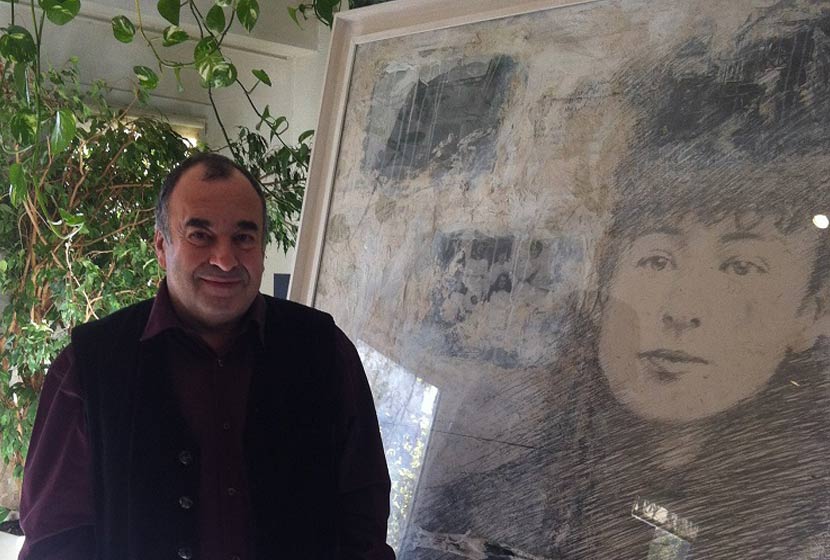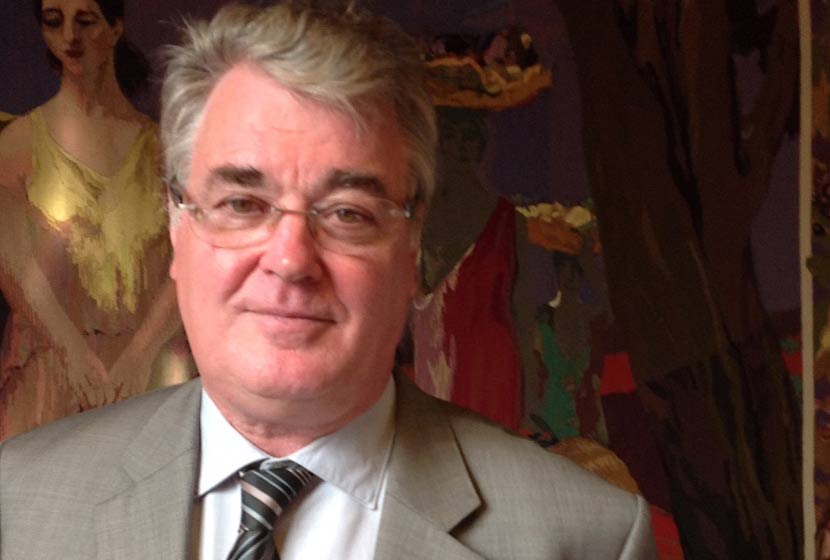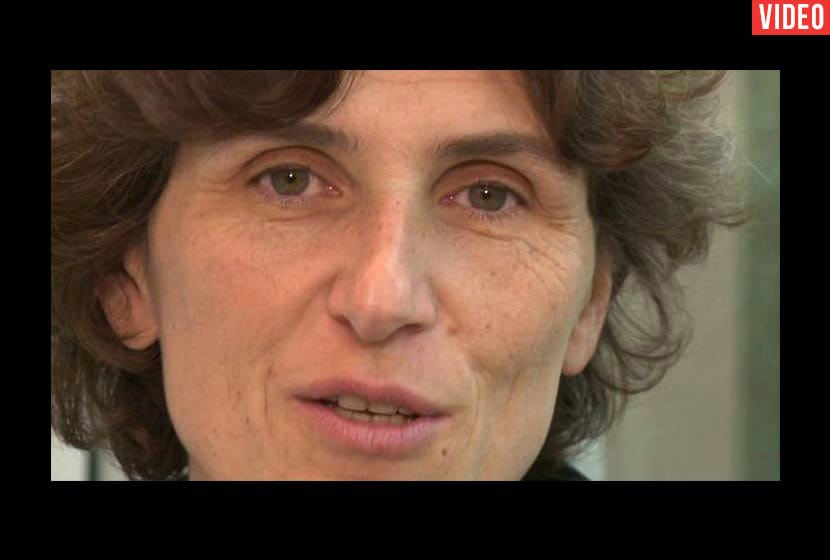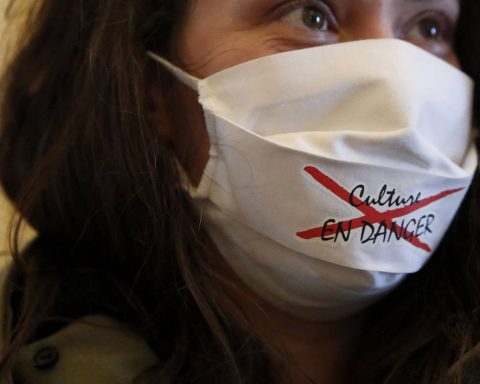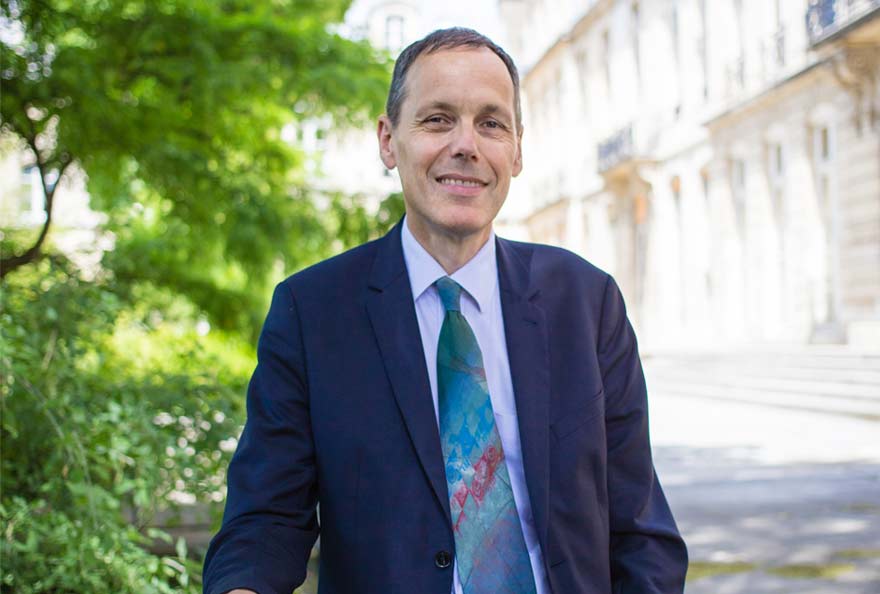The title was easy because they all said it, from Aragon to Jack Lang or Peter Samis, via Alain Finkielkraut, Elie Wiesel or Georges Moustaki! "The embodiment of a myth of memory, a collective memory." for Pierre Restany, art critic, theorist of the school of the New Realists; "Warm sumptuousness as a gift" for the painter Hastaire, enemy of the ponciff,...
Alain Kleinmann's work wavers quietly between the mystery of "the subtle traces of absence, of the silence of voices that are forever silent". (1) and a "chiaroscuro of the web weaving the fabric of our indoor climate"...(2) for a reverie varying from diaphanous, transparent, to sepia or brown, blue, brushed or traced colours. Paule Pérez, philosopher, psychoanalyst and friend of the painter says of him: " Alain Kleinmann paints through generations of canvases around an idea that holds him - theme, state, object, photo, small remnants or shreds, salvaged materials, architecture, or even a joke - and an idea will give rise to a series of five, ten, twenty works that are at once different and related, translating together a 'moment' of the artist.
UP' had the privilege of sharing one of his moments, in his studio in the centre of Paris, where each work transposes memories and extracts from past lives into a daily life linking appearances and disappearances for a timeless perception.
![]() Alain Kleinmann, what is the common theme of your works?
Alain Kleinmann, what is the common theme of your works?
 Alain Kleinmann It is generally said that it is a work on memory, which is right. But the downside is that the only real theme in the painting is the painting itself. That is to say, by only highlighting the thematic side, we omit the most essential part of the work, which is the work on colours, shapes, materials, spaces; and I am convinced that, deep down, a painter's motivation comes from the development of his language, which is essentially based on his relationship to painting itself. Having said that, as far as I am concerned, because there are paintings that are more abstract, or with less meaning, it is certain that one of the human or historical or psychological motivations is to work around memory; it is also linked to the generation in which I was born.
Alain Kleinmann It is generally said that it is a work on memory, which is right. But the downside is that the only real theme in the painting is the painting itself. That is to say, by only highlighting the thematic side, we omit the most essential part of the work, which is the work on colours, shapes, materials, spaces; and I am convinced that, deep down, a painter's motivation comes from the development of his language, which is essentially based on his relationship to painting itself. Having said that, as far as I am concerned, because there are paintings that are more abstract, or with less meaning, it is certain that one of the human or historical or psychological motivations is to work around memory; it is also linked to the generation in which I was born.
![]() Is working on memory an act of projection into the future?
Is working on memory an act of projection into the future?
AK Yes, indeed: for a tree to have fruit, it must first have branches, a trunk and roots, and the idea of working on memory is precisely a way of solidly developing an idea of the future. Otherwise, without roots, they are more fragile ideas. For me, this is not a past-ist activity, on the contrary! It is a willingness to think about the present, the future and in prospective.
![]() Your work gives the idea of wanting to make sense. Would you say, like Braque, that "the test tires reality"?
Your work gives the idea of wanting to make sense. Would you say, like Braque, that "the test tires reality"?
AK What does Braque call "the test"? Referring a little to Mathematics, the truth or theorem is constructed in the test or by the test, that is to say by demonstration, by experience, by the accumulation of previous moments. From this point of view, the test makes the truth. And makes it live.
In painting, for example, what is the painter's ordeal? I can't see very well... Painting? The working time or the difficulty?
![]() Wasn't he referring more to the trials of life?
Wasn't he referring more to the trials of life?
AK : So there we have two parallel logics. But it's not a question of a test but rather a question of time given to one or the other. If that means that any time taken for another activity in life is missing from the activity that is essential to us, that's for sure. But are they trials? There are wonderful things, joys, complementary things that enrich painting...
Instead, let's go back to your original question about "work that wants to make sense". Because that is very close to my heart. I find that one of the real problems of contemporary painting is precisely "absence", a kind of emptiness where the activity itself is no longer at the service of elements that are essential for man. It's very playful, superficial, it's often a game of stock market value, a game a little external to what could be deep concerns... And, all of a sudden, I find that the whole meaning and historical place of art changes position, which becomes a kind of collapse of the hope of saying something.
What does the meaning mean? All definitions coexist: nonsense is a meaning, like the dadaist or surrealist nonsense that establishes a new meaning, and there is a nonsense that is much less like the big three-metre-high "Mickey Mouse" or plastic roses that can be seen in contemporary art fairs. I don't see at all how that's much better than my son's "Michey Mouse" figurine.
So I think we have the right to question the question of meaning and you are right as far as I am concerned, I never state the meaning of my painting definitively since that would become a slogan and that would cover any hope of research and investigation around that. But I do work with the idea anyway that in the end there is hope in something that I could find and that would be something to say to the other. If I didn't have this feeling and if I didn't feel this engine in my workshop, I would do something else!
![]() Precisely, in your type of work, and your friend Paule Pérez, Philosopher, wrote it very well on several occasions in some of your catalogues, one feels this sensation of calm, almost of murmuring in your work. How do you explain it, when certain messages are not particularly soothing?
Precisely, in your type of work, and your friend Paule Pérez, Philosopher, wrote it very well on several occasions in some of your catalogues, one feels this sensation of calm, almost of murmuring in your work. How do you explain it, when certain messages are not particularly soothing?
AK This may explain this! On the one hand there is a personal sensitivity, preferring whispering to shouting, suggestion to violent assertion. Some painters prefer the frank colours of a paint pot and shout what they have to say on the canvas. Me, I am sensitive to delicacy and I find this message more powerful because the scar remains more moving than the wound. In particular, since I talk in my work about a painful moment in history, I see only this way of talking about it.
On a canvas, a lot of material, colour and next to it, there was a drawing representing the same subject that I put next to it in the exhibitions. And it's as if, as a painter, I was between these two figurations, as if I was in two states: that of the matter that can represent power and a state where just the untiedness of the subject represented as a transparency. There is always in an expression the suggestion that it can be said otherwise.
![]() I'll talk about chemistry in your work.
I'll talk about chemistry in your work.
 AK : Indeed, this is the right word because it is indeed about the alchemy of material transformation. Or mutation because one matter can become another. The remaining idea is to make gold from lead.
AK : Indeed, this is the right word because it is indeed about the alchemy of material transformation. Or mutation because one matter can become another. The remaining idea is to make gold from lead.
The palette of a painter is not only the tubes of paint, linseed oil, turpentine, brushes, ... but each object, because it remains the bearer of a certain meaning and can become one of the elements in the composition of a canvas. I therefore tested a certain number of elements and materials that are a priori exogenous to painting but which, in retrospect, integrate perfectly into it. It's a choice because not all materials have these qualities and I therefore snooped through flea markets and flea markets for significant fragments of an object's life, a trace of someone or something, ... a memory. A memory that they kept against all odds: in an old armchair, you find the shape of the person who sat there. You find the hand of a former owner... By testing all these discoveries, quite naturally, it became a kind of complementary vocabulary to my painting. This led me to a fairly natural diagonal between sculpture or the world of three-dimensional objects and painting, the world of two-dimensional objects.
Today I no longer make any difference in nature between a painting, a drawing, a sculpture, a watercolour, an installation. It seems to be about the same vocabulary to try to define the same subject.
![]() Would you say that art is like science, an act of research?
Would you say that art is like science, an act of research?
AK: Not only do I say it, but it's one of my "dadas"! My real training is scientific, having done a master's degree in mathematics, a doctorate in semiology on the relationship between formalized languages in mathematics and natural languages, I have always affirmed, contrary to the preconceived ideas on the nature of art that we believe to be foolish, that it is a research tool in the same way as the exact sciences. For example, there is a true history of art in the same way as there is a history of science: in science, a theorem can only exist if it is based on the preceding historical theorems and it will allow the development of the following theorem. And historically, and in the logic of language. And painting is exactly that, we can demonstrate that the history of painting, the succession of movements, let's say since the Italian Renaissance, enters into a real logic: a movement exists only because it is posterior to the preceding one, that it takes up the
hypotheses, that he transforms them, that he questions them, that he modifies them, with a few epi-phenomena: sometimes, we see a painter being immediately on a questioning that will perhaps only appear in the historical cogs two centuries later. A position like a lightning bolt or a shortcut to the relationship to the future, so to speak, while the engine of art history continues to run. It is a vision that does not generally appeal to those who sell art because the discourse is always to say that there is an exceptional individual who has no father, no brother, no historical circumstances and who suddenly finds a form and therefore it is worth millions of dollars because it is "outside history". As if a mathematician alone, all at once and by himself, invented all mathematics! These are false ideas and I applaud your vision of bringing art and science together!

![]() A painter's studio is like a laboratory for experimentation...
A painter's studio is like a laboratory for experimentation...
AK : The breaks in art or science are as in a continuity, no pun intended. Discoveries are ruptures with what has gone before and these ruptures are not necessarily conscious at the moment they occur. To speak of a rupture, one must rely on a comparison with what has gone before. Even if at the first degree one takes the rupture as a counter-position, it is already a continuation, a story. Rupture designates successive movements and always within a certain logic.
So it helps to demonstrate that there is a stepped story, as all scientific stories are.
Let's talk about impressionism: it is a reaction against realism. Let's take Turner: he accelerated the reaction, thus sensed all the possible hypotheses on his own and before it took place in the form of a movement and a historical group. There are several examples of such historical figures: at no time did they betray the history of painting; they accelerated it.
![]() The rhythm of the world is changing, giving an ephemeral character to artistic works: do you think contemporary art could disappear?
The rhythm of the world is changing, giving an ephemeral character to artistic works: do you think contemporary art could disappear?
AK First of all, contemporary art is at a given time the state of art at a given moment T. So we have a contemporary art now, as in the 16th century we had one.
So, as such, there is no reason for it to disappear since this is the state of speech at a given time for humanity. What is the relationship between the acceleration of the rhythm of things and its relation to artistic language? We can say that, since there is an acceleration of the rhythm, it perhaps downgrades the deep relationship to the arts, but it may also be exactly the opposite: it's when things accelerate and scatter that there is a need for a reef, a backbone, points of reference that allow us to serenely and more deeply reassociate the relationship to thinking, reading, philosophy, aesthetics,... Nothing says that these social movements are harmful or favourable to deepening things. Perhaps it is a little more difficult to be a philosopher today because there is an overabundance of signs, there is such an innovation in fireworks in all fields combined, that to make a structural or exhaustive analysis, ...
As far as painting is concerned, it is a more precise field that interacts with contemporary situations in general but, at the same time, the painter's work escapes a little bit by nature from all this. There are some artists whose discourse is to be like a reflection of this overabundance of information, which gives fast, ephemeral, first-degree, zapping creations... It continues to be a kind of neo-pop-art invented in the 60s.
Modernity is nowadays a source of inspiration for thousands of active painters, no matter how happily they produce their works.
![]() So it's about the freedom to create...
So it's about the freedom to create...
AK There is a question to be asked here. Normally, one is free, but to be free, one must think that one is an expert in the field, that one has the authority to say "I like it" or "I don't like it", and for years I have noticed that the people who work at the FIAC, for example, can only applaud because it is the official art that is presented.
We come back to Marcel Duchamp's question of the pissoir put in a museum: from the moment you put a pissoir in a museum, since it becomes a museum object, people are in a psychological situation to say that it's beautiful, important, cultural... We're really still there! Even though I have heard several times on TV journalists daring to say that some works were the repetition of a thousand things already seen, with a false effect of invention or contemporaneity. So where is the freedom of galleries, and what about the official financial system of Culture?
Interview by Fabienne Marion
(1) About Elyette Lévy-Heisbourg
(2) Paule Pérez's words
 Catalogue raisonné 2014 ©Alain Kleinmann
Catalogue raisonné 2014 ©Alain Kleinmann

